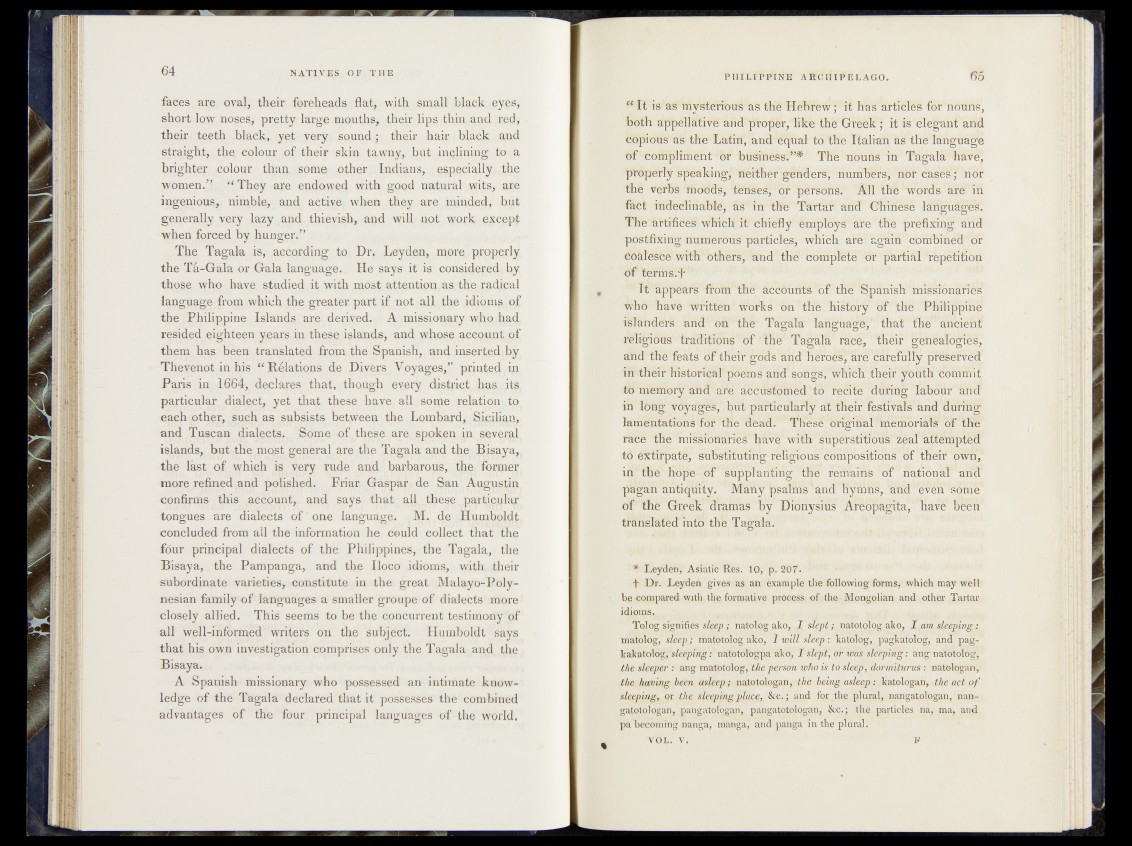
faces are oval, their fgrehgads flat, with small
short low.noses, pretty large mouths, their lips Thin and ,r,edj
their teeth black, yet very sound; their hair black and
jrimight, tha eolopT.pf their skin_ tawny, but ipqliuing to i a
brighter., colour thap,. sptp^ . other
women/’ | | They are endowed with good natural wits, are
ingenious., nimble, anti active; when they, are minded» M|l
generally very lazy and_ thievish, apd will not work except
when forced by hunger,” ;
The Tagala is, „according to Dr. Leyden, more,rpropprly
the Ta-Gula or Gala language. He says it is considered, by
those who have studied it with most attention, as, the radjpal
language from which the greater part if not all the idiomsfpf
the Philippine Islands are derived. ;. A missionary w is hed,
resided eighteen years in these islands, and whose pccount of
them; has been translated from the Spanish, and insertefliby
Thevenot in his “ Relations de Divers Voyages,” printed , in
Paris in 1664, declares that, though every districtfrha^ ,itss
particular dialect, yet that these have all {-some relatiqpf fff
each .other, such as subsists between the Lombard, ‘Sicilian,
and Tuscan dialects., Some-of these are spoken ip several,
islands, but the most general are the Tagala and the Bjsaya,,
the last of which is very rude and barbarous, the former
more refined ,and polished. Friar-Gaspar de San Augustin,
confirms this account, and says that all these parti cplaf
tongues are dialects of one language. .M. de\JEIumt>old.t.
concluded from all the information he could collect that the
four principal dialects of the Philippines, the Tagala, the
Bisaya, the Pampanga, and the Iloco idioms, with their
subordinate varieties, constitute in the great Malayo-Poly-
nesian family of: languages a smaller groupe of dialects more
closely allied. This seems to be the concurrent testimony of
all well-informed writers on the subject. Humboldt says
that his own investigation comprises only the Tagala and the
Bisaya.
A Spanish missionary who possessed an intimate knowledge
of the Tagala declared that it possesses the combined
advantages of the four principal languages of-the world.
M It KSiÿlIrtîëlél for norths,
both rippélldtive* and^propèr, like thëf’Grèek ; if is ele§aht and
dopiofls as the Latin, and,:équa4 textile
of' cotriplimehf^or" bu^rhils?®* The riounsHh 'Tâ^alà^hàv^
properly Speaking/ Weiffibrigewders; m im t t ; ’ribf Va^s f riot
the verbs Tnooâ% Sfdr' pdrèbriâ/ All tlfe “words Tire* Yii
fact ind'ecliriabiè’, âsHn'thW Ta'rfi^’’arid’ ChîriMë -iririgukge^!
The Urtificrif which *it! ch’iflfly eniplbyS^aVe The preflifh^ ' arid
postfixirig numerous p artie l^ which ■ are- 1 cbm'bin^H^or
coalesce* with *bthers^ Tend the*' compi^t^ oT partfôl'frep^frabn
d f terrii^f 1
It appears from' thdwcb'Ôùnts h f the '^aria^sl?1 kii
Whô haVè written works on the history of? hiiippfhp
ikMhdrir^ hrid^bri ’the Tagala lanriuagl!, that thè”*amcie^f
religious fraditidhs^bf "The* Tagalk'* rkce^'fhèir jgeribafogfesf
rind tnë Tests’ of their ^ofl's;knd hWol^'kre^refutlÿ pfd^erved
in their historical1 poems aricP songs/ which their Vouth coiriiriit
to memory andl areaccu’stbmed'to lècitë du ri fig labour arid4
in lori‘g*vdya^es, but particularly at their festivals and. during/
lameritations for me dead. Th’es^ôriglrfer^nemoriàls w ’tflri
rade thev misSforiaries havd * with Superstitious^ zeailiftempted
to extirpate, substituting religious cornpositRms of tneir oivn, 4
in the hope-ofJ supplanting the remains 'of national arid
pligari antiquity. Mariy psalms and hymns, ’and^Wlh' -sc^MT
of thë Greek dramas by Dionysuts' .Arèopagïta, have*’ueeîri
translated into the Tagala.
* Leyden/ AsÜtie ftCs. #0/p. 207“.
f Dr. Leyden gives as an example the following forms, which may well
be compared with the formative process? of .the; Mongolian and othor Tartar
idioms.
Tolog signifies s le e p ; nalolog ako, ,1 s le p t; natotplog-ako, I sam sleep in g *
matolog, sle e p ; matotolog ako, I w ill s le e p : katolog, pagkatolog, and pag-
kakatolog,'sZe^piMgr näfdfo&gpä akdj I slep t, d P P tö kM iß ßm fg 1: h^hafMölog/
th e s le e p e r : ang matotolog, th e p erso n w ho is to sleep, d o tm itu r u s : natolbga'n,
th e ' h a y in g been asleep »•MnaWologafi, th e b ein g asleep m l
slee p in g , o ith e s le e p in g p lo p e , &c.; and for the plural,.nangatologan, nan-
gatotologan, pangatologan, pangatotologan, See.; the particles na, ma, anil
pa becoming nanga, manga, and panga in the plural.
« VOL. V. P